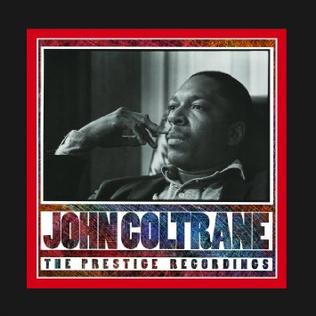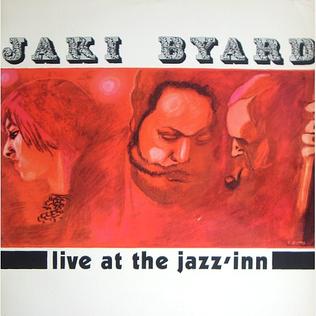
Tadley Ewing Peake Dameron was an American jazz composer, arranger, and pianist.
Coltrane changes are a harmonic progression variation using substitute chords over common jazz chord progressions. These substitution patterns were first demonstrated by jazz musician John Coltrane on the albums Bags & Trane and Cannonball Adderley Quintet in Chicago. Coltrane continued his explorations on the 1960 album Giant Steps and expanded on the substitution cycle in his compositions "Giant Steps" and "Countdown", the latter of which is a reharmonized version of Eddie Vinson's "Tune Up". The Coltrane changes are a standard advanced harmonic substitution used in jazz improvisation.

Blue Train is a studio album by the jazz saxophonist and composer John Coltrane. It was released through Blue Note Records in January 1958. It is Coltrane's only session as leader for Blue Note. The recording took place at Rudy Van Gelder's studio on September 15, 1957.

Rhythm changes is a common 32-bar jazz chord progression derived from George Gershwin's "I Got Rhythm". The progression is in AABA form, with each A section based on repetitions of the ubiquitous I–vi–ii–V sequence (or variants such as iii–vi–ii–V), and the B section using a circle of fifths sequence based on III7–VI7–II7–V7, a progression which is sometimes given passing chords.
In music, a major seventh chord is a seventh chord in which the third is a major third above the root and the seventh is a major seventh above the root. The major seventh chord, sometimes also called a Delta chord, can be written as maj7, M7, Δ, ⑦, etc. The "7" does not have to be superscripted, but if it is, then any alterations, added tones, or omissions are usually also superscripted. For example, the major seventh chord built on C, commonly written as Cmaj7, has pitches C–E–G–B:

In jazz, a turnaround is a passage at the end of a section which leads to the next section. This next section is most often the repetition of the previous section or the entire piece or song.
The ii–V–I progression is a common cadential chord progression used in a wide variety of music genres, including jazz harmony. It is a succession of chords whose roots descend in fifths from the second degree (supertonic) to the fifth degree (dominant), and finally to the tonic. In a major key, the supertonic triad (ii) is minor, and in a minor key it is diminished. The dominant is, in its normal form, a major triad and commonly a dominant seventh chord. With the addition of chord alterations, substitutions, and extensions, limitless variations exist on this simple formula.

Soultrane is a studio album by the jazz musician John Coltrane. It was released in 1958 through Prestige Records, with catalogue no. 7142. It was recorded at the studio of Rudy Van Gelder in Hackensack, New Jersey, three days after a Columbia Records session for Miles Davis and the Milestones album.

Mating Call is a studio album by jazz musician Tadd Dameron with saxophonist John Coltrane, issued in early 1957 on Prestige Records. It was recorded at the studio of Rudy Van Gelder in Hackensack, New Jersey.

The Prestige Recordings is a box set by jazz musician John Coltrane.
In music, harmonization is the chordal accompaniment to a line or melody: "Using chords and melodies together, making harmony by stacking scale tones as triads".
In jazz, the Tadd Dameron turnaround, named for Tadd Dameron, "is a very common turnaround in the jazz idiom", derived from a typical I−vi−ii−V turnaround through the application of tritone substitution of all but the first chord, thus yielding, in C major:
"Our Delight" is a 1946 jazz standard, composed by Tadd Dameron. It is considered one of his best compositions along with "Good Bait", "Hot House", "If You Could See Me Now", and "Lady Bird". It has an AABA construction. A moderately fast bebop song, it featured the trumpeter Fats Navarro, who is said to "exhibit mastery of the difficult chord progression". One author said, "'Our Delight' is a genuine song, a bubbly, jaggedly ascending theme that sticks in one's mind, enriched by harmonic interplay between a flaming trumpet section led by Dizzy, creamy moaning reeds and crooning trombones. The written accompaniments to the solos-in particular the leader's two statements-are full of inventiveness, creating call-and-response patterns and counter-melodies. What is boppish here is the off-center, syncopated melody, as well as the shifting, internal voicings of the chords, especially at the very end. These voicings, along with a love of tuneful melodies that one walks out of a jazz club humming, were Tadd's main legacy to such composers and arrangers as Benny Golson, Gigi Gryce, and Jimmy Heath." Rolling Stone describes it as a "bop gem". The first publication is by Dizzy Gillespie in August 1946. In total there are more than 120 covers of Our Delight. Bill Evans recorded his version of it for his debut album New Jazz Conceptions in 1956.
"Good Bait" is a jazz composition written by American jazz piano player and composer Tadd Dameron and by band leader Count Basie. It was introduced in 1944 and was popular in the 1940s and 1950s.

Live at the Jazz'Inn is a live album by pianist Jaki Byard recorded in Paris in 1971 released on the French Futura label.
"Lady Bird" is a sixteen-bar jazz standard by Tadd Dameron. This "celebrated" composition, "one of the most performed in modern jazz", was written around 1939, and released in 1948. Featuring, "a suave, mellow theme," it is the origin of the Tadd Dameron turnaround (in C: CM7 E♭7 A♭M7 D♭7 CM7).

Barry Harris Plays Tadd Dameron is an album by pianist Barry Harris featuring compositions associated with Tadd Dameron. It was recorded in 1975 and released on the Xanadu label.

Blues in the Closet is a 1983 album by jazz pianist Tommy Flanagan, bassist Ron Carter and drummer Tony Williams, known collectively as The Master Trio.

Catalonian Nights Vol. 1 is a live album by pianist Tete Montoliu recorded in Spain in 1980 and released on the Danish label, SteepleChase.










